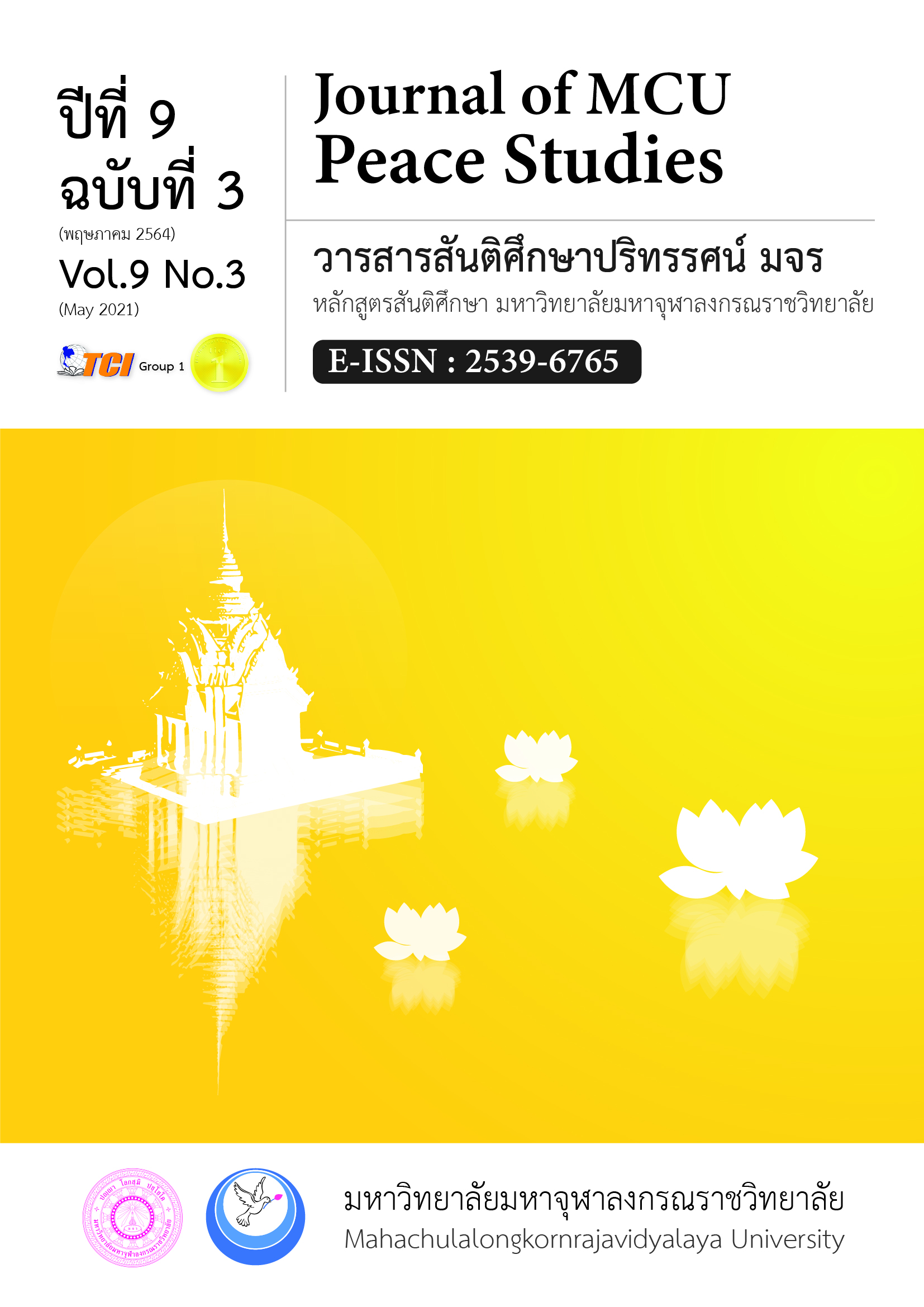การพัฒนาสัปปายะสถานที่เอื้อต่อการปฎิบัติธรรม ของสถาบันสติภาวนาเพื่อสันติภาพ อำเภอปรางค์กู่ จังหวัดศรีสะเกษ
Main Article Content
บทคัดย่อ
บทความนี้มีวัตถุประสงค์ 1) เพื่อศึกษาบริบท และสภาพความต้องการที่เอื้อต่อการปฏิบัติธรรม ของสถาบันสติภาวนาเพื่อสันติภาพ 2) เพื่อพัฒนาสับปายะสถานที่เอื้อต่อการปฏิบัติธรรมตามแนววิทยาการสมัยใหม่ และพุทธศาสนาเถรวาท และ 3) เพื่อนำเสนอการพัฒนาสัปปายะสถานที่เอื้อต่อการปฏิบัติธรรม ของสถาบันสติภาวนาเพื่อสันติภาพ เป็นการวิจัยเชิงพัฒนา โดยเก็บรวบรวมข้อมูลจากการสัมภาษณ์เชิงลึกกลุ่มผู้ใช้ประโยชน์พื้นฐานและผู้เชี่ยวชาญจำนวน 48 ท่าน การสนทนากลุ่มจากผู้ทรงคุณวุฒิจำนวน 12 ท่าน เครื่องมือที่ในการวิจัย ได้แก่ แบบสัมภาษณ์เชิงลึกการสนทนากลุ่ม แล้ววิเคราะห์ข้อมูลด้วยเทคนิคการวิเคราะห์เชิงเนื้อหา ผลการวิจัยพบว่า 1) บริบทและสภาพความต้องการคือ ชุมชนและชาวบ้านส่วนใหญ่เห็นด้วย อยาก มีสถาบันสติภาวนาเพื่อสันติภาพและเน้นการจัดการให้ยั่งยืน 2) การพัฒนาสัปปายะสถานที่เอื้อต่อการปฏิบัติธรรมของสถาบันสติภาวนาเพื่อสันติภาพตามสมัยใหม่และพุทธศาสนาเถรวาท ประกอบด้วย (1) อาวาสสัปปายะ (ที่อยู่เป็นสุขสบาย) (2) อาหารสัปปายะ (อาหารเป็นที่สบาย) (3) บุคคลสัปปายะ (บุคคลเป็นที่สบาย)และ (4) ธรรมสัปปายะ (ธรรมเป็นที่สบาย) และ 3) นำเสนอโมเดลการพัฒนาสัปปายะสถานที่เอื้อต่อการปฎิบัติธรรมของสถาบันสติภาวนาเพื่อสันติภาพนั้นต้องประกอบด้วย สัปปายะ 4 ที่ส่งผลให้ผู้ปฎิบัติได้รับภาวนา 4 คือ (1) กาย (ภาวิตกาย) ผู้ที่มีกายพัฒนา กิน อยู่ ดูฟังเป็น (2) ศีล(ภาวิตศีล)สามารถอยู่, มีปฎิสัมพันธ์กับผู้อื่น (3) จิต (ภาวิตจิต) พัฒนาจิตที่ดีแล้ว (4) ปัญญา (ภาวิตปัญญา) ปัญญาที่พัฒนาแล้วเพื่อให้เกิดความยั่งยืนพัฒนาสู่มิติอนาคตให้เป็นศูนย์รวมของทุกวัยให้มีสติในการดำรงชีวิตในอนาคตต่อไป
Article Details
ทัศนะและความคิดเห็นที่ปรากฏในบทความในวารสาร ถือเป็นความรับผิดชอบของผู้เขียนบทความนั้น และไม่ถือเป็นทัศนะและความรับผิดชอบของกองบรรณาธิการ ยินยอมว่าบทความเป็นลิขสิทธิ์ของวารสาร
เอกสารอ้างอิง
Bureau of International Cooperation Ministry of Education, Thailand. (2015). Constitution of the Organization. Retrieved April 6, 2020, from https://www.bic.moe.go.th/index.php/unesco-others-menu/unesco-menu
Chan-o-cha, P. (Prime Minister of the Kingdom of Policy statement of the Cabinet). (2020). Publishers of the State Council and the Royal. (1st ed.). Bangkok: MCU Press.
Food and Agriculture Organization of the United Nations. (2020). Communication in Rural Development. Retrieved April 16, 2020 from https://www.http://elearning.psru.ac.th/courses/153/lesson
Kardkaew, T. (2004). The Seventh of Sappaya: Equilibrium for Family and Social Principle. HCU Journal HCU journal of social sciences and humanities, 15(8), 80-92.
Luang Por Dhammajayo. (2020). There is no happiness other than peace. Retrieved March 10, 2020, from https://kalyanamitra.org/th/article_detail.php?i=12319.
Mindfulness Institute for Peace. (2020). Auspicious day of Auspicious day of MakhaBucha! Building construction Mindfulness Institute for Peace in the Southern Isan Region. Retrieved April 22, 2020, from https://www.banmuang.co.th/news/education/142526
Phra Dharmakosajarn, (PrayoonDhammajitto). (2013). Sa-pa-ya 4. (12st ed.). Bangkok: Mahachulalongkornrajavidyalaya University Press.
Phra Dharmakosajarn, (PrayoonDhammajitto). (2016). The principle of personal development. (28th ed.). Bangkok: Mahachulalongkornrajavidyalaya University Press.
SCG Green building Solution. (2020). Greenbuilding material. Retrieved April 22, 2020, from http://greenbuilding-material.com/#welcome/0
The National Legislative Assembly, (2020). The study of presenting Thailand as the center of global concentration. Retrieved April 22, 2020, from https://www.senate.go.th/assets/portals/22/fileups/148/files/Thelatestvolumesoftheworldmeditationreport.pdf
Vacharaphol. (2020). Phra Vipassana Master. Retrieved May 7, 2020, from http://greenbuilding-material.com/#welcome/0; https://palungjit.org/threads
Yingkra, N. (2015). Royal Thai Government Gazette.the Organization. Retrieved April 6, 2020, from https://www.bic.moe.go.th/index.php/unesco-others-menu/unesco-menu
Yaot, S. (2020). Suitable Monastic Areas Development. Journal of Education Periscope, 6(2), 202.


